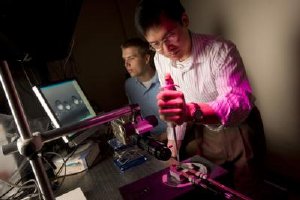Oct 26 2009
What do spore-launching mushrooms have in common with highly water-repellant
surfaces?
 Pictured are Jonathan Boreyko, left, and Chuan-Hua Chen of Duke University. Credit: Duke University Photography
Pictured are Jonathan Boreyko, left, and Chuan-Hua Chen of Duke University. Credit: Duke University Photography
According to Duke University
engineers, the answer is "jumping" water droplets. As it turns out,
the same phenomenon that occurs when it's time for certain mushrooms to eject
spores also occurs when dew droplets skitter across a surface that is highly
water repellant, or superhydrophobic.
Using a specially designed high-speed camera and microscope set-up, the engineers
for the first time captured the actions of tiny water droplets on a man-made
superhydrophobic surface, and to their surprise found that the droplets literally
jumped straight up and off the surface.
Simply put, when two tiny water droplets – whether on a mushroom's spore
or on a water-repellent surface – meet to form a larger drop, enough energy
is released in the formation of the new droplet to cause it to "jump"
off the surface.
"This spontaneous jumping is powered by the surface energy released when
droplets coalesce," said Jonathan Boreyko, a third-year graduate student
at Duke's Pratt School of Engineering, who works in the laboratory of Assistant
Professor Chuan-Hua Chen. "Because this process involves very tiny droplets
at high speeds, no one had captured this phenomenon before."
The results of the team's experiments were published early online in the journal
Physics Review Letters.
"A similar phenomenon occurs with the ejection of spores, known as ballistospores,
from certain kinds of mushrooms," Boreyko said. "When a drop of water
condensate at the base of the spore comes into contact with the wetted spore,
it triggers the propulsion of the spore into the air."
Chen and Boreyko's research is the first known engineering reproduction of
the ballistospore ejection process.
The work also has immediate applications in energy harvesting and thermal management,
Chen said. For example, the spontaneous jumping motion offers an internal mechanism,
independent of gravity, to remove condensate from the condensers in power plants.
The superhydrophobic surface used by the researchers is characterized by rows
and rows of tiny bumps, covered with even tinier hairs projecting upward. When
a water droplet lands on this type of surface, it only touches the ends of the
tiny hairs. This creates pockets of air underneath the droplet that keeps it
from touching the surface. This cushion of air keeping the droplet aloft is
much like a puck in an air-hockey game. The same principle allows water striders
to skim along the surface of ponds without falling into the water, Chen said.
"When two of these condensate drops coalesce into one, they jump at very
high speeds," Boreyko said. "They move as fast as one meter per second.
By taking a side view of the phenomenon, we can plainly see the droplets jump.
You wouldn't see it looking down on the surface."
Interestingly, the researchers found that the mechanism used to eject ballistospores
is almost identical. The critical size of the droplet on the spore for the jumping
to occur is the same as that on the man-made superhydrophobic surface, and spores
"jump" off the mushroom at about the same speed.
Chen said knowing how superhydrophobic surfaces are able to repel condensate
drops could lead to improvements in many types of systems where heat needs to
be removed through condensation.
"Smaller water droplets are much more efficient at transferring heat,"
Chen explained. "With the jumping mechanism, the average droplet size is
about one hundred times smaller.
"In conventional cooling systems, as in big industrial plants, condensate
must be removed using external forces for continuous operation," Chen said.
"One of the main benefits of this superhydrophobic surface is that it needs
no external energy – the coalescing of the droplets provides all the energy
needed to remove the condensate."